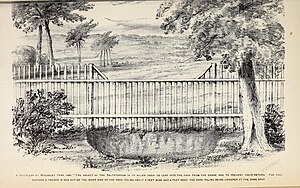Salter (trap)
Salter is a type of trap used primarily for the capture of animals, both in hunting and wildlife management. The term "salter" originates from the practice of using salt as a lure to attract animals. This method has been utilized for centuries, as many animals, particularly herbivores like deer, are attracted to salt licks or salt blocks placed by hunters or wildlife managers. Over time, the term has evolved to encompass a variety of trapping mechanisms that may or may not use salt as an attractant.
History[edit | edit source]
The use of salt to attract animals is an ancient practice, with evidence suggesting its use in hunting and animal husbandry dating back thousands of years. Early humans discovered that animals were drawn to natural salt deposits, and they began to exploit this behavior by setting traps or lying in wait near these sites. As human ingenuity progressed, more sophisticated methods of trapping animals using salt as bait were developed.
Types of Salters[edit | edit source]
There are several types of salters, each designed for specific animals and environments:
- Salt Licks: These are blocks of salt, often combined with minerals, placed in the wild or in enclosures to attract animals. While not a trap in the traditional sense, salt licks are used to draw animals to a specific location for observation, hunting, or for the purpose of wildlife management.
- Baited Traps: Traditional traps, such as cage traps or foot traps, may be considered salters when salt or salted bait is used to lure animals. These traps are designed to capture animals alive without causing harm, allowing for relocation or study.
- Electronic Salters: Modern wildlife management has introduced electronic devices that use salt or mineral attractants to monitor animal movements. These devices may trigger cameras or counting mechanisms rather than physically trapping the animal.
Usage[edit | edit source]
Salters are used in a variety of contexts:
- Hunting: Hunters use salt licks and baited traps to attract game to specific areas. This practice can increase the success rate of hunts by concentrating animals in known locations.
- Wildlife Management: Conservationists and wildlife managers use salters to monitor animal populations, study behavior, and manage the health of wildlife. Salt licks can also be used to supplement the diet of animals in areas where minerals are scarce.
- Pest Control: In some cases, salters may be used as part of pest control strategies, particularly for large rodents or other animals that are attracted to salt.
Ethical Considerations[edit | edit source]
The use of salters, particularly in hunting, raises ethical questions. Critics argue that baiting animals with salt or other attractants can lead to overhunting and may disrupt natural behaviors and ecosystems. Proponents, however, maintain that when used responsibly, salters can be an effective tool for sustainable wildlife management and conservation efforts.
Regulations[edit | edit source]
Many jurisdictions have specific regulations governing the use of salters and bait in hunting and wildlife management. These laws may restrict the types of bait that can be used, the placement of salt licks or traps, and the timing of their use. It is important for individuals using salters to be familiar with and adhere to these regulations to ensure ethical and legal practices.
Search WikiMD
Ad.Tired of being Overweight? Try W8MD's physician weight loss program.
Semaglutide (Ozempic / Wegovy and Tirzepatide (Mounjaro / Zepbound) available.
Advertise on WikiMD
|
WikiMD's Wellness Encyclopedia |
| Let Food Be Thy Medicine Medicine Thy Food - Hippocrates |
Translate this page: - East Asian
中文,
日本,
한국어,
South Asian
हिन्दी,
தமிழ்,
తెలుగు,
Urdu,
ಕನ್ನಡ,
Southeast Asian
Indonesian,
Vietnamese,
Thai,
မြန်မာဘာသာ,
বাংলা
European
español,
Deutsch,
français,
Greek,
português do Brasil,
polski,
română,
русский,
Nederlands,
norsk,
svenska,
suomi,
Italian
Middle Eastern & African
عربى,
Turkish,
Persian,
Hebrew,
Afrikaans,
isiZulu,
Kiswahili,
Other
Bulgarian,
Hungarian,
Czech,
Swedish,
മലയാളം,
मराठी,
ਪੰਜਾਬੀ,
ગુજરાતી,
Portuguese,
Ukrainian
Medical Disclaimer: WikiMD is not a substitute for professional medical advice. The information on WikiMD is provided as an information resource only, may be incorrect, outdated or misleading, and is not to be used or relied on for any diagnostic or treatment purposes. Please consult your health care provider before making any healthcare decisions or for guidance about a specific medical condition. WikiMD expressly disclaims responsibility, and shall have no liability, for any damages, loss, injury, or liability whatsoever suffered as a result of your reliance on the information contained in this site. By visiting this site you agree to the foregoing terms and conditions, which may from time to time be changed or supplemented by WikiMD. If you do not agree to the foregoing terms and conditions, you should not enter or use this site. See full disclaimer.
Credits:Most images are courtesy of Wikimedia commons, and templates Wikipedia, licensed under CC BY SA or similar.
Contributors: Prab R. Tumpati, MD

